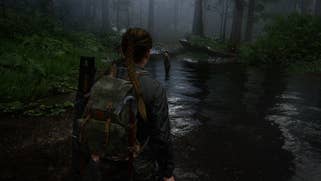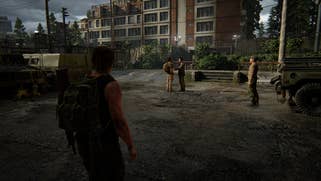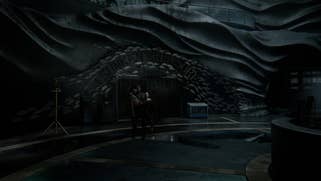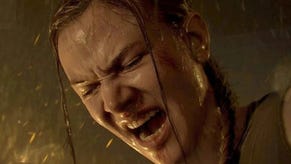PS5 Pro and PSSR impress in The Last of Us Part 2 Remastered
The full-fat Digital Foundry tech analysis of the new Pro mode.
I think it's fair to say that The Last of Us Part 2 Remastered is perhaps not the highest priority when it comes to receiving a PS5 Pro upgrade. Packing a reasonable 1440p60 and 4K30 performance split on base PS5 consoles, the game was already delivering a good visual experience on Sony's 2020 hardware - but there is a compromise between image fluidity and image clarity. Part 2's PS5 Pro outing seeks to eliminate that gap, aiming to deliver a 4K-like visual experience at a full-fat 60fps frame-rate target by using Sony's new machine learning PSSR upscaling solution. How does PSSR fare in our first extended look at the technology? Is this a good replacement for native 4K, or does it fall short of that lofty target?
Developer Naughty Dog is refreshingly open about the basic rendering setup in this update. The new "Pro" mode delivers a 4K final image with PSSR upsampling from a 1440p internal resolution at 60fps. That means we're looking at a new rendering option that superficially seems similar to the old Performance mode, with the same internal rendering resolution and frame-rate target, so most image quality differences here should come down to that new reconstruction method.
In side-by-sides, the PSSR upscale is delivering a lot of extra image detail relative to the old 1440p render. The difference can be surprisingly stark at times, like with the fine textures and water droplets on Abby's backpack, which are rendered with much more detail on Pro. Part 2 has some very nice art assets, and PSSR exposes a lot of texture detail that's obscured on the base machine. It also does a good job of avoiding moiré patterns on fine texture detail, which is very good for an upsampling solution. Texture art at oblique angles also resolves more clearly, though I believe anisotropic filtering settings are unchanged.
Geometric edges also look quite a bit sharper and better-defined than on the base console. The PS5 looked fine, but had a slightly soft-focus look on a 4K set, with edge detail deadened by a more moderate rendering resolution combined with TAA. The Pro delivers a much stronger result here, without the blurred edges characteristic of regular upscalers. Perhaps the most obvious edge though comes down to the way the game's alpha-tested foliage resolves. The game's old foliage had a slightly rough appearance at range, and tended to look coarser in general, even at a closer distance to the camera. PSSR is doing a better job of resolving these elements, and it looks like the art may have been tweaked to help accommodate this as well.
Image detail at rest is improved quite a lot overall. The extent that matters depends on how you choose to play PS5 - whether you view the game at close range on a monitor, where image clarity differences are often more apparent, or at a longer distance on a TV, where sometimes they can seem more subdued. One issue that is quite apparent at all viewing ranges is image breakup, as flickering on high-contrast edges tends to catch the eye even if a slight softness throughout the frame is harder to perceive.
Here the Pro delivers solid results. Pushing forward through the scene tends to cause quite a lot of image breakup on the regular console, as you can observe the appearance of aliasing over many frames, but the Pro is substantially better. Foliage in particular sees a big bump, with slight AI upscale artifacts and a bit of blur proving preferable to the aliasing that was dominant before. In some instances, we find similar breakup across both machines, but PS5 Pro typically provides a lot more image detail as a trade-off.






Other typical pain points for temporal AA techniques tend to fare reasonably well here. Hair appears a bit less dithered and resolves with more detail. Screen space reflections often appear more temporally stable here and coherent, though I did note a small visual bug in one scene, and puddles sometimes reveal additional checkerboard-like SSR artifacts on Pro. There's also no obvious issues with 2D elements like snowflakes, which can sometimes cause issues with trails in some reconstruction solutions.
The comparison with performance mode perhaps flatters the Pro a little bit, because the baseline expectation is that the Pro should be delivering a better image. But what about the PS5's fidelity mode, which offers a full 4K image with TAA at a default 30fps?
The most obvious difference is that the Pro is actually resolving more image detail, which is especially clear in texture art. Edge detail also appears somewhat sharper, and the foliage - in common with the performance mode - takes on a more refined appearance on Pro. I do think it's important to realise that some of these detail bumps are not going to be apparent from a typical viewing distance for most players, given the 4K image on the base machine, but if we do take a closer look they stand out.
There are definitely some elements where PSSR is just doing a flat-out better job resolving fine detail than the old TAA, like rendering distinct bars in a metal fence in the background of a scene. Sometimes it does look just a touch sharp though to my eyes, which wouldn't be that noticeable on a TV screen but does sometimes look slightly unnatural in close-ups.
One rare exception can come down to water rendering, where fast-moving streams can suffer from a little bit of additional blur here across the water surface, with a softer riverbed below. Here, the performance mode and Pro deliver similar results, with the fidelity mode appearing substantially sharper. Moving transparencies like this often suffer a bit with reconstruction, though the results here look fine enough.
Image stability is somewhat more mixed. Head-to-heads in most scenes reveal that both machines offer a consistent and temporally stable image from a normal viewing distance. There is a bit of a trend on Pro to resolve a bit more detail, while also suffering from extra image breakup. For instance, hanging strings on the base console become faint and flicker lightly in and out of view, while the Pro resolves sharper lines that have a tendency to pulse over multiple frames. The Pro definitely delivers clearer foliage rendering, but we do see obvious breakup - and occasionally a bit of PSSR blur as well. Rarely, scenes expose substantially more breakup on Pro than the base console. In typical play though, I think both options are doing a good enough job.






Most of the underlying visual settings on PS5 Pro though appear to be the same as the PS5 performance mode. This seems pretty common on PS5 Pro 60fps modes, but it doesn't affect the visuals much at all here because those settings are nearly identical to begin with. In certain rare instances, we can observe a bit of pop-in that isn't present in the fidelity mode, like with these sandbags in this cutscene, where the performance mode and Pro deliver identical results. It's also evident in this shot, where I was able to engineer just the slightest bit of pop-in on Pro and the performance mode - but not the fidelity mode. I really have to go out of my way here as this is extremely challenging to spot in almost all of my comparison footage.
The only other visual change of note is depth of field, which is deeper on Pro than in either PS5 mode. The depth of field in the fidelity mode and Pro appears to count at the same 1080p resolution, but the upsampling process to 4K may be decreasing that blurring effect. On some occasions the intersection of in-focus and out-of-focus elements can produce a bit of a haloing effect on Pro, though this is also evident at different moments in the PS5 modes as well. There are also some issues with some things appearing to not render correctly on Pro, but these minor discrepancies are likely to be bugs that will be fixed for launch.
Perhaps the most interesting point of comparison for Sony's new upsampling solution is going to come against FSR and DLSS temporal upscalers on PC. Unfortunately, we don't have a version of TLOU Part 2 on PC as of yet, but The Last of Us Part 1 can serve as a stand-in for quick-and-dirty comparisons.






Relative to AMD's FSR 3, PSSR has clear merits. FSR tends to suffer from a lot of disocclusion issues and aliasing in general whenever there's motion on screen, which PSSR handles much more gracefully. That classic salt-and-pepper pattern of disocclusion fizzle is absent on Pro, and the image in general looks more stable over multiple frames, even with the same base resolution. I suspect that in most titles, the difference between FSR and PSSR will favour the latter, given the kinds of issues we've seen with FSR 2 and 3 since their inception.
DLSS is the gold standard for image reconstruction on PC for good reason, with stable imagery across a wide range of game content, and the results in TLOU Part 1 are certainly in line with that trend. We get top-class image quality on PC, especially relative to FSR 3.
PSSR tends to present with a bit of extra image breakup on geometric edges and foliage in comparison to DLSS, at least in its early incarnation here. PSSR's infancy is key though, as DLSS has had nearly six years of in-the-wild deployment to develop and evolve to what we have today. Sony developers have confirmed that they've already seen substantial performance and quality improvements with PSSR so far, and I expect that trend will continue. But in the here and now, PSSR at least seems better than FSR at delivering a temporally stable image.
As a final note, performance in the new Pro mode appears basically faultless in the footage we've seen so far. A small debug performance counter in the bottom right hand corner of the screen showed a constant 60fps reading, and that solidity is reflected in our own tools too. Cutscene camera cuts are an exception, where a frame appears to be held for anti-aliasing purposes, which drops a single 16ms frame right as the game switches to a new camera angle. Camera cuts while inspecting objects appear to be held for AA as well, and I suspect that other gameplay camera cuts may behave similarly.
Interestingly, Naughty Dog is leaving the old PS5 modes in as well - alongside an option to unlock the frame-rate entirely on VRR panels, like we've seen with prior Naughty Dog efforts on PS5. According to the developer though, these older modes really just exist on PS5 Pro as a reminder of how the game looked before. That said, if the full power of the Pro is deployed in the older modes with unlocked frame-rates, you should see a substantial performance edge over the base console. It's likely the 40fps fidelity mode option will remain as well when using 120Hz output with the unlocked toggle on, but without VRR enabled.
Overall, I'd say the PS5 Pro's rendition of The Last of Us Part 2 seems successful, even in this pre-release state. It delivers a credible looking 4K image with excellent detail and pretty good image stability, at a virtually flawless 60fps update. It's effectively as Mark Cerny put it in the PS5 Pro announcement video - "achieving fidelity-like graphics at performance frame-rate". Rich came away with similar impressions from his capture session, as he actually played and recorded the PS5 Pro devkit capture used for the accompanying video and screenshots above.
Looking forward, I'd be very curious to see how PSSR behaves with lower input resolutions and more challenging game content. The Last of Us offers a satisfying 1440p to 4K upscale, but a lot of demanding PS5 software runs with sub-1080p internal resolutions, sometimes with noisy RT effects. In those situations, FSR is really not up to the task of delivering a stable looking, reasonably sharp image. That bar will be more challenging for PSSR to clear, but that's going to be important in titles like Star Wars Outlaws and Alan Wake 2, both of which are slated to receive Pro upgrades.
For now, early indications suggest PSSR, in combination with the Pro, is capable of delivering a solid 4K60 experience in a range of PS5 software, including in The Last of Us Part 2 Remastered.











